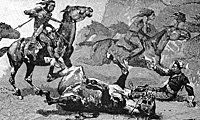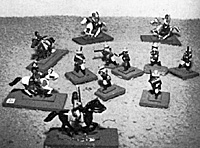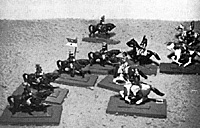 These rules were developed for the 15mm
range of figures produced by Peter Laing.
Unfortunately, before they were extensively play
tested the author moved onto a 35 foot wood Ketch
(Sailboat). This somewhat limits the amount and
type of wargaming conducted. The intent of the
rules was to provide a game somewhere between
the Skirmisher and the one figure equals one Troop
type.
These rules were developed for the 15mm
range of figures produced by Peter Laing.
Unfortunately, before they were extensively play
tested the author moved onto a 35 foot wood Ketch
(Sailboat). This somewhat limits the amount and
type of wargaming conducted. The intent of the
rules was to provide a game somewhere between
the Skirmisher and the one figure equals one Troop
type.
TURN SEQUENCE
- Morale check (To determine heroic
status)
Orders (Individual, Troop, Company or Warband)
Movement (Simultaneous)
Firing
Melee
SCALE
One figure equals one to five persons; 15mm equals 5 feet, and one turn equals one minute.
MORALE CHECK
Morale is checked at the start of each turn only if the unit is surrounded and outnumbered 4: 1 or better or they are ordered to perform a suicidal or heroic act ("Sam, take two men and charge those 100 Indians on that hill"). If the morale check is good no further checks are made for the rest of the game. If it fails each turn thereafter an attempt must be made to rally. Once rallied they are good for the rest of the game.
To the number of figures alive, add the following:
-
Regular 10
Indian Warrior 8
Militia 5
Other Indians 5
Civilian 2
Innocent Bystander 0
Subtract 10 for being outnumbered 10:1 or more. If total is . . .
50 or higher -- Charge nearest enemy
30-49 -- Obey orders
20-29 -- Halt, may fire and melee.
10-19 -- Halt, may fire only, if meleed run
away 300mm, lose one figure to enemy (may be
captured)
0-9 -- Run 300mm away from enemy, lose two figures
HOW TO RALLY
Each turn recompute number. For a rally, 10-19 if not in contact with the enemy, 20-29 if in contact. Otherwise continue to run at a rate of 250mm per turn.
ORDERS
Orders must be simple, clear and complete. Firing and melee are considered to be automatic, orders need not specify either. Movement and reaction orders are critical and must be written. Some examples are: "Move 150mm towards hill to right front." "Charge enemy to left front." "Change from column to line." "Evade enemy charge, maintain 60mm from lead enemy."
If orders are considered too complex use alternate move system and dice for initiative.
MOVEMENT
| Type | Crawl | Slow Walk | Run/Trot | Charge |
|---|---|---|---|---|
| Dismounted | 60mm | 150mm | 250mm | 300mm |
| Mounted | -- | 150mm | 300mm | 600mm |
| Vehicles | -- | 150mm | 300mm | 400mm |
FORMATIONS
Formation changes take one move (mounting and dismounting are not formation changes but should be ordered). The unit may not move forward and make a formation change, however, it may fire and make a formation change.
Only Regular and Militia units use formations, Indians and civilians travel in "bunches."
FORMATION TYPE
 Single column: three or more figures one behind another, not more than one figure wide.
Single column: three or more figures one behind another, not more than one figure wide.
Double column: six or more figures one behind another, not more than two figures wide.
Column mass: more than six figures one behind another, not less than three figures wide.
Single line: one figure deep.
Double line: two figures deep.
Echelon Right/Left: Units in column or line.
Circle: only formation used by civilians or Indians, similar to square in that all figures face outwards. Minimum of 10 figures needed to form and may not move and fire.
FIRING
| Rate of Fire | Range | |||
|---|---|---|---|---|
| Close | Medium | Maximum | ||
| Rifles | 3 rds | 30mm | 600mm | 1500mm |
| Muskets | 1 rd | 30mm | 450mm | 900mm |
| Carbines | 1 rd | 30mm | 300mm | 600mm |
| Bows | 1 ar | 30mm | 150mm | 300mm |
| Pistols | 3 rd | 30mm | 75mm | 150mm |
| Spears | 1 sr | 30mm | 60mm | 120mm |
| Axes, warclubs, rocks,etc. | 1 | 15mm | 30mm | 60mm |
CHANCE TO HIT
| Situation | Range | ||
|---|---|---|---|
| Close | Medium | Maximum | |
| Firer stationary | 90% | 52% | 19% |
| Firer or target moving | 24% | 19% | Missed |
| Both moving | 19% | -- | -- |
Rate of fire is per turn. Pistols take one complete turn to reload. All others reload as they fire.
Normally only the front rank or those figures have to have a CLEAR line of sight may fire. If the unit orders for the front rank to lie on the ground, second rank to kneel, and the third rank to stand, all ranks may fire. Indians and civilians may shoot past or between friendlies, however, they have 24% chance of hitting their own people. When firing on prone figures it is an automatic 24% to hit if stationary and 19% if moving.
AMMUNITION
Each figure carries 50 rounds of ammunition their primary weapon and 24 rounds for pistol/piss (this does not include the 6 rounds in each pistol. An additional 40 rounds are carried in saddle bags. Pack horses/mules carry 200 rounds per animal. It requires two complete moves with no other actions to secure ammo from saddle bags or packs (PS: bring Pacs).
MELEE
BASIC
- Indian with lance 4
Regular with saber 3
Regular/lndian with musket or rifle butt/bayonet Militia with saber 2
Indian with tomahawk or militia with musket or rifle butt/bayonet 1
All others 0
ADD TO BASIC
- If mounted 3
If charging or entrenched 2
CHANCE TO WIN
| Minus or 0 difference | 19% |
| 1 point difference | 24% |
| 2 point difference | 43% |
| 3 point difference | 52% |
| 4 point difference | 57% |
| 5 point difference | 62% |
| 6 point difference or better | 76% |
EXAMPLE ONE: A mounted Indian with lance charges a mounted civilian
| Indian | Civilian | ||
|---|---|---|---|
| with lance | 4 | Mounted | 3 |
| Mounted | 3 | - | |
| Charging | 2 | - | |
| Total | 9 | . | 3 |
Difference is 6 or 76% chance to kill for the Indian and 19% to kill for the civilian. Both roll percentage dice and check results.
EXAMPLE TWO: A mounted regular with saber charges an Indian entrenched in a rifle pit and armed with a musket:
| Regular | Indian | ||
|---|---|---|---|
| With saber | 3 | With musket | 2 |
| Mounted | 3 | Entrenched | 2 |
| Charging | 2 | - | |
| Total | 8 | . | 4 |
Difference is 4 or 57% for the regular to kill and 19% for the Indian.
FATIGUE
As each move equals a minute, fatigue only becomes a factor after the 10th consecutive move at other than a slow walk. A figure may walk one move, run 9 moves and walk one without fatigue becoming a factor.
Fatigue penalty: Halt for three moves or slow walk for five. Firing drops to 19% and two is subtracted from the melee total. After the penalty is paid full powers are restored.
WATER
Non-lndian units must have two pack animals per 40 men allocated to carry water. If these are killed or captured by the Indians the unit must either retreat or start towards the nearest water at the end of five moves. After ten moves the unit is fatigued.
AMBUSH
A unit that is ambushed may not return fire until the next turn. A 24% chance exists to discover a nonlndian ambush. If discovered, fire may be returned and the ambush charged without orders.
ARTILLERY
Artillery should be limited to one cannon or galling gun for the non-lndians. Both were rarely used except in defensive positions.
Cannons: minimum crew to fire every turn is 4; every other turn, 3; every fourth turn, 2. Maximum range for ball is 4500mm. Kills all figures in a direct line from muzzle to point of aim (except prone). Requires three moves to load ball or shell.
Maximum range for shell is also 4500mm. Specific range must be ordered; i.e. shell, 500mm, hilltop right front. 24% chance for the shell not to explode (a dud!). 62% chance of being on target in which case all figures are killed which are within 30mm of the impact point. For a miss roll one die; 1,2 over, 3,4 under, 5 right, 6 left. Shell lands 90mm in the direction rolled.
Maximum range for canister is 300mm. Canister pattern is 45 degrees. Roll two dice for number of kills. Only two rounds of canister are allowed per game.
A minimum of four horses are needed to move any gun. Once limbered, use walk speed. Limbered gun may trot for five consecutive turns and then must go back to a walk. To limber or unlimber requires five moves. Artillerymen may fire small arms or melee only when not doing any other action.
Gatling Guns: Maximum range is 900mm, 52% chance for a hit, roll one die for number of kills within 90mm of aiming point. Gatling guns were extremely ineffective and were rarely used outside of defensive sites With a limber the gun may be fired for ten turns, without limber two turns. A jam may be cleared in five turns.
| Turn one | 24% chance of jamming |
| Turn two | 242% chance of jamming |
| Turn three | 252% chance of jamming |
| Turn four | 267% chance of jamming |
| Turn five | 272% chance of jamming |
| Turn six through ten | 290% chance of jamming |
ENTRENCHMENTS/COVER
This includes buildings, trees, rocks, wells, rifle pits, etc. (Little known historical fact -- American Indians used "rifle" pits, "Fox" holes, and trenches long before the paleface accidently bumped into the Western Hemisphere.) It takes five turns to dig-in one person. No other action is allowed while digging.
Small arms fire is automatically 19% against figures under cover. Only Artillery shells and balls will penetrate buildings with 52% chance to kill. Against all other cover, artillery has a 62% chance for a kill.
SMOKE/BRUSH FIRES
Small arms fire from prone figures has a 19% chance of causing brush fires. They can also be set deliberately without a die roll. Wind direction is determined by a die roll; 1 -- north, 2 -- south, 3 -- east, 4 -- west, 5,6 -- no wind. Smoke/fire travels 90mm a turn and lasts for ten turns. Width of fire is 60mm for each fire set. Individuals/animals in the path of a fire have a 19% chance of being killed. Smoke restricts vision, fire restricts movement. No one may move through fire. As fire moves 90mm, the past 90mm becomes smoke only. Movement through smoke is allowed, however, no other action may occur and the movement speed is run/trot.
Horses panic when within 30rnm of fire/smoke. They have a 43% chance of running directly away from the fire/smoke for two turns. Blind firing is allowed through fire with a 19% chance for a hit.
TERRAIN
 Woods: Foot and horse movement 1/2 slow
walk, no vehicular movement. Visibility is 300mm and
small arms/galling gun fire is 19% at close and medium -
range. A 24% chance exists for firing from any position to
start a brush fire.
Woods: Foot and horse movement 1/2 slow
walk, no vehicular movement. Visibility is 300mm and
small arms/galling gun fire is 19% at close and medium -
range. A 24% chance exists for firing from any position to
start a brush fire.
Hills/buttes/high ground: All movement is 1/2 slow walk going up hill and normal going down hill.
Streams: Movement is 1/2 slow walk for all. 19% chance for individuals on foot, armed with small arms to get their powder wet. If this occurs they may not use their ammunition for the remainder of the game.
WEATHER
| Die Roll | Effect | Restrictions |
|---|---|---|
| 1-5 | Clear & Hot, dust storm possible on turn ten (19% chance) | Dust- visibility 300mm, movement at a walk, all firing at 24%, lasts for six turns. |
| 6 | Adverse weather, roll again: 1-2 = rain; 3 - 4 = dust storm; 5-6 = high wind. | Rain: visibility 900mm, no faster movement than a trot/run, all firing at 52% or lower. Lasts for 5 turns. High Wind: visibility 400mm, no movement, other than a crawl, all firing at 19%, lasts for 4 turns. |
NOTES ON ORGANIZATION
The actual paper organization of regular US Army units from 1870 to 1890 varied quite a bit. The field strength and local modifications by commanders further confuses the issue. The following is a "type" organization circa 1881:
- Infantry Company -- 41 (two officers, ten NCOs
and 29 privates)
Cavalry Troop -- 58 (two officers, ten NCOs and 46 privates)
Artillery Battery -- 40 (two officers, ten NCOs and 28 privates) Three field pieces.
Militia (Volunteer) Cavalry -- 30 to 40 men, one or two officers.
Indian Scouts -- Not more than five per Cavalry Troop. Tribes include Crows, Pawnees, Arickaras, and Shoshones.
Hostile tribes -- Bands of 10 to 20 with 5 to 10 bands per tribe. Tribes include Kiowas, Comanches, Kiowa-Apaches, Cheyennes, Arapahoes, various Sioux, Blackfeet, Apaches, etc.
SOME INDIAN FIGHTS
THE FETTERMAN FIGHT: 21 Dec 1866
- Regulars -- 51 Infantry, 27 Cavalry, and two
civilians
Indians -- 2,000+ Sioux and Cheyenne
Results -- 40,000 arrows used. All regulars were killed. Estimated 60 Indians killed and 300 wounded.
THE BATTLE OF BEECHER'S ISLAND 16 Sept 1868
- Regulars -- 50 Cavalry
Indians -- 600+ Sioux, Cheyennes and Arapahoes
Results -- Regulars five killed and 16 wounded. Indians nine killed and 18 wounded.
THE BATTLE OF THE ROSEBUD: 16 June 1876
- Regulars -- 1,302 (201 Inf, 839 Cavalry, 176 Crow
and 86 Shoshoni Indians)
Indians -- 1750+ Sioux
Results -- US fired off 25,000 rounds of ammunition. US: 28 killed and 56 wounded. Indians: 13 killed, unknown wounded.
THE BATTLE OF WHITE BUD CREEK: 17 June 1877
- Regulars -- 103 Cavalry and 11
civilians.
Indians -- approx. 75 Nez Perces
Results -- US: 34 killed and 4 wounded. Indians: two wounded.
THE BATTLE OF CLEARWATER: 11 J uly 1877
- US -- 480 Cavalry, 100 civilians and Indian
scouts, one howitzer and one gatling
gun.
Indians -- 100+ Nez Perces
Results -- The US force formed a circle while the Indians surrounded them and dug rifle pits!!! US: 13 killed and 20 wounded. Indians: Five killed and 10 wounded.
THE BATTLE OF THE LITTLE BIG HOLE: 9 Aug 1877
- US -- 163 Infantry in wagons and 35 civilians.
Indians -- 150 Nez Perces, men, women, and children in camp.
Results -- US: 29 killed and 40 wounded. Indians: 12 killed and 20 wounded.
REFERENCES
Primary: Frontier Regulars, Robert M. Utley, 1973, Macmillan, N.Y.
Background: Time/Life series The West, specifically The Chiefs and The Indian Fighters.
By Valor & Arms vol II, numbers 1 & 2, 1975-1976, Valor & Arms press, Ft Collins, Co.
ERRATA
Rate of fire should be changed to 3 rounds per turn for rifles and 1 arrow per turn for bows.
Back to Table of Contents -- Courier Vol. 2 #4
To Courier List of Issues
To MagWeb Master Magazine List
© Copyright 1981 by The Courier Publishing Company.
This article appears in MagWeb (Magazine Web) on the Internet World Wide Web.
Other military history articles and gaming articles are available at http://www.magweb.com